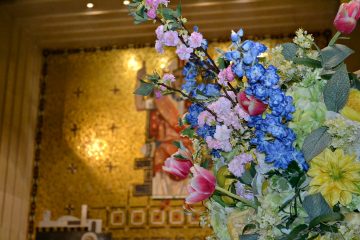For Trinidad Carnival, Catholic students learn African warrior tradition

IMAGE: CNS photo/Laura Ann Phillips
By Laura Ann Phillips
PORT-OF-SPAIN, Trinidad (CNS) — A Catholic all-male secondary school in Trinidad and Tobago has adopted an unusual element in its student formation program: a traditional African warrior craft called kalinda, also known as stick fighting.
Once banned among African slaves, kalinda survived underground in rural districts over the centuries. It’s now an essential component of an annual Carnival re-enactment of the 19th century Canboulay Riots, when newly emancipated slaves fought for true freedom from a still-influential plantocracy.
Students of Fatima College are taught that history and are encouraged to internalize the social justice element while perfecting the physical.
"Stick fighting has a particular place in our history, and the children have to recognize that as citizens," said Spiritan Father Gregory Augustine, Fatima principal. "Sometimes, we convey a Gospel that is very soft, but Jesus is passionate about what he is conveying to us.
"We have to be passionate, too," he said. "You can’t win justice by simply saying, ‘Well, I want a just society’ and everybody will smile at each other? No! That doesn’t happen! You have to fight for it!"
Free-style combative and exhibition kalinda was featured at the school’s annual Carnival show Feb. 28.
Today, kalinda bears hues of theater art but, it is really a form of martial art. It came to Trinidad on 18th-century slave ships bearing Africans for sale; some of them had been warriors back home.
Among the slaves, stick fighting flourished on the plantations. Spectators formed a ring called a gayelle, the battle space. Each warrior was armed with a "bois," pronounced "bwa", meaning "wood" in Patois, the fusion of French, English and various African dialects once spoken in Trinidad. The bois was a hand-crafted stick about four feet in length with a two-inch diameter, taken from any hardwood tree, usually, the poui, a flowering tree that bloomed in the weeks preceding Easter.
One bois man, as the warriors were called, threw his bois inside the gayelle; the man who accepted the overt challenge entered it. Combat ensued at the explosive pounding of goatskin drums, much like starter guns at an athletic meet. Continuous spectator chants, accompanied by frenzied drumming, fueled a conflict that often ended in serious injury or death. The aim, after all, was to make your opponent bleed; blood-holes were made at every gayelle so that fighters could bleed out into them.
Bois men were highly respected, intimidating even plantation owners. Fearing that stick fighting would eventually incite revolt, Trinidad’s rulers banned it across the island.
Contemporary kalinda competitions throughout the country keep many of the original elements but are less bloody, with ambulances present. The student at Fatima College learn these aspects, with further safety tweaks made at the school.
The school’s younger students learn the craft but remain as spectators until they enter third form, an eighth- or ninth-grade equivalent — and are allowed to enter the Drama and Theater Arts gayelle. Reinforced plastic PVC pipes are used instead of wooden bois, and the boys are expected to aim for an opponent’s feet rather than the head. Still, minor injuries occur.
"There is a certain risk, but, that’s life," said Father Augustine. "The boys have to take their knocks, and they do; they take it very well."
The principal said there were approximately 60 boys in the stick fighting group. "We’re teaching them the values of life: that you have to be able to withstand pressure, to take a challenge and to rise to the occasion."
"It’s not about violence, per se," said Shimiere Douglas, drama and theater arts teacher. "It’s showing their prowess and their strength and their bravery."
Douglas, a former dancer, introduced stick fighting to the school five years ago and teaches the boys to fight. That’s unusual; to this day, stick fighting in Trinidad has remained exclusively a male domain, which is precisely the reason Douglas decided to teach it.
"It’s a boy school. I am a female teacher and I wanted to make sure that they got something that’s got its roots in masculine traditions," she explained, adding that even the shyest of boys thrive in it. "This has become a nice brotherhood space; a nice, safe space to be a guy.
"It’s away from the academics — nobody’s smarter than anybody because stick fighting can’t happen just with the fighters. You need the drummer, you need the person who can write the chant, you need the person who can sing the chant. So, they realize how important each person is to the process."
Douglas also finds common ground between the bois man and Jesus’ salvific action.
"The bravery," she said, simply. "In the ring, you know you’ll end up with a bruise, but you do it because you know everybody is counting on you. I think that’s what Jesus did for the multitude, (saying), ‘I’m going to get in a position where I know something is going to happen to me, but it’s for all these other people.’ That’s what performers do. You sacrifice yourself, you become vulnerable."
– – –
Copyright © 2019 Catholic News Service/U.S. Conference of Catholic Bishops. www.catholicnews.com. All rights reserved. Republishing or redistributing of CNS content, including by framing or similar means without prior permission, is prohibited. You may link to stories on our public site. This copy is for your personal, non-commercial use only. To request permission for republishing or redistributing of CNS content, please contact permissions at [email protected].













